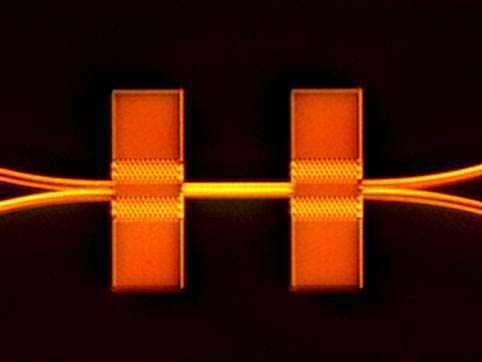Light's Repulsive Force Discovered

A newly discovered repulsive aspect to light could one day control telecommunications devices with greater speed and less power, researchers said today.
The discovery was made by splitting infrared light into two beams that each travel on a different length of silicon nanowire, called a waveguide. The two light beams became out of phase with one another, creating a push, or repulsive force, with an intensity that can be controlled; the more out of phase the two light beams, the stronger the force.
"We can control how the light beams interact," said Mo Li, a postdoctoral associate in electrical engineering at Yale University. "This is not possible in free space — it is only possible when light is confined in the nanoscale waveguides that are placed so close to each other on the chip."
The discovery could lead to nanodevices controlled by light rather than electricity.
Li and colleagues previously discovered an "attractive" force of light and showed how it could be manipulated to move components in semiconducting micro- and nano-electrical systems — tiny mechanical switches on a chip.
"This completes the picture," Tang said. "We've shown that this is indeed a bipolar light force with both an attractive and repulsive component."
The team, led by Yale assistant professor Hong Tang, details its findings today in the online version of the journal Nature Photonics.
Get the world’s most fascinating discoveries delivered straight to your inbox.
The attractive and repulsive light forces are different than the force created by light's radiation pressure, which pushes against an object as light shines on it. An example of where this can have great effect is on an asteroid, which over millennia has its orbit around the sun altered by subtle but constant radiation pressure, or with solar sails, pitched as a way to ride the sun's pressure into the deep cosmos.
The newfound forces, however, push out or pull in sideways from the direction the light travels.
Previously, the engineers used the attractive force they discovered to move components on the silicon chip in one direction, such as pulling on a nanoscale switch to open it, but were unable to push it in the opposite direction. Using both forces means they can now have complete control and can manipulate components in both directions.
"We've demonstrated that these are tunable forces we can engineer," Tang said.
An added benefit of using light rather than electricity is that it can be routed through a circuit with almost no interference in signal, and it eliminates the need to lay down large numbers of electrical wires, the researchers said in a statement.
The work was funded by the U.S. Defense Advanced Research Projects Agency and the National Science Foundation.

